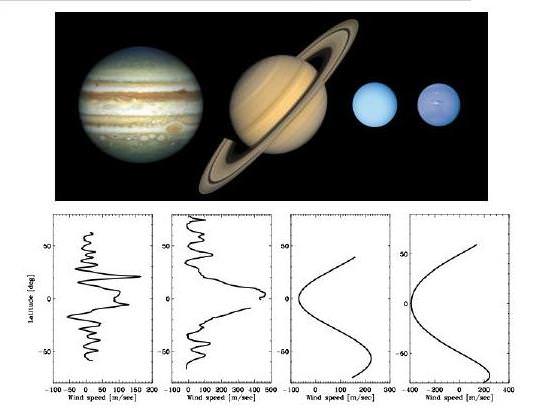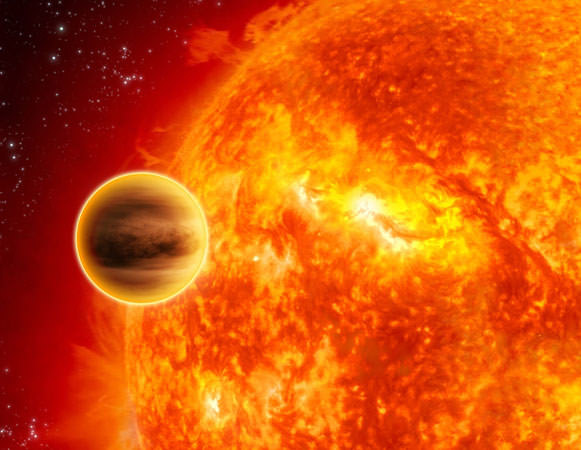Trying to determine the behaviour of the atmosphere of a hot Jupiter – a gas giant so close to its star that it is either tidally locked or caught in a slow orbital resonance – is tricky, given that we have no precedents here in our solar system. But it is possible to explore in detail what exoplanet atmospheres might be like, based on solar system examples.
For example, there’s Venus – which, although not tidally locked, has such a slow rotation (once every 243 Earth days) that its dynamics virtually match those of a tidally locked planet.
Interestingly, Venus’ upper atmosphere super-rotates, meaning it circulates in the same direction as the planet’s rotation but much faster – in Venus’ case, at sixty times the speed of the planet’s rotation. It’s likely that these winds are driven by the large temperature gradient that exists between the day and night sides of the planet.
Conversely Earth, with its rapid rotation, has much less potential difference between its day and night side temperatures – so that its weather systems are more strongly influenced by the actual rotation of the planet and also by the temperature gradient between equator and pole. The nett result is lots of circular weather systems with their direction determined by the Coriolis effect – counter-clockwise in the northern hemisphere and clockwise in the southern.
And of course we do have gas giants, even if they aren’t hot. Being so far from the Sun, dayside-nightside and equator-pole temperature gradients have little influence on our gas giants’ atmospheric circulation. The most significant issues are each planet’s rotation speed and each planet’s size.
Jupiter and Saturn’s larger radius exceeds their Rhines scale forcing the bulk flow of their atmospheres to break up into distinct bands with turbulent eddies between them. However, the smaller radius of Uranus and Neptune allows the bulk of the atmosphere to circulate as an unbroken whole, only breaking into two smaller bands at each pole.

Partly because it’s cooler, but mostly because it’s smaller, Neptune’s atmosphere has much less turbulent flow than Jupiter – which goes some way to explaining why it has the fastest stratospheric wind speeds in the solar system.
All these factors are useful in trying to determine how the atmosphere of a hot Jupiter might behave. Being so close to their star, it’s likely these planets will be partly or fully tidally locked – so the main driver for atmospheric circulation will be, like Venus, the dayside-nightside temperature gradient . So a super-rotating stratosphere, circulating many times faster than the inner parts of the planet, is plausible.
From there, modelling suggests that the combination of fast wind speed and slow rotation means the Rhines scale will become bigger than a Jupiter-sized planetary radius , so there will be less turbulent flow and the upper atmosphere might circulate as one, without breaking up into the multiple bands we see on Jupiter.
Anyway, that’s my take on an interesting 50 page arXiv article with lots of (to me) bewildering formulae, but also lots of comprehensible narrative and diagrams. The article consolidates current thinking and lays a sound foundation for making sense of future observational data – both hallmarks of a nicely crafted ‘lit review’.


The operating equation is the Navier-Stokes equation. This is a continuity equation. Basically it says that the time derivative of the density of a fluid or gas, usually thought of as being in a volume or flowing in and out of a volume, is equal to the density of that fluid times the divergence of the velocity. The divergence is the degree to which the vectors of the flow spread apart. So a circular flow has zero devergence.
Of course it gets pretty complicated in the application from then on. There is a $1 million prize by the ClayMath organization for a proof which demonstrates the solution sets for the Navier-Stokes equation.
LC
Me, I’m glad it’s not a 100 pages review.
It does seem likely. But perhaps there is a problem (though I certainly don’t know enough to say):
“Astrophysicists have long speculated that the difference in temperature between the day and the night side of Venus at 300K and 100K respectively, is what drives these winds. But there’s a problem with this calculation [sic]
The puzzle is that the Venusian atmosphere has a certain viscosity and so, by itself, ought to dissipate energy at a rate of 10^9 W and slow down. Something else must be injecting energy into the system at this rate. How does this happen?”
The proposed solution is presumably interesting for those who works with the ionosphere and its coupling to the solar wind and its momentum:
“Today, Héctor Javier Durand-Manterola and pals from the Universidad Nacional Autónoma de México say they have solved the puzzle. They point out that in addition to the ordinary atmospheric winds, there is another much faster flow higher above the planet. These are ionic winds in the ionosphere between 150 and 800 km above the surface and were discovered by the Pioneer Venus Orbiter in the early 80s.
Known as the transterminator flow, these winds travel at supersonic speeds of several kilometres per second, probably driven by the planet’s interaction with the solar wind.”
Since that process injects an order of a magnitude more energy than is dissipated, it is a plausible solution in that regard. The paper also test the directionality mechanism of the momentum transfer proposal in a model system.
For good measure, the authors note that it takes a mere ~ 10^6 years for the superrotation to develop from a standstill.
D’oh! “an order of a magnitude more energy than is dissipated” in the superrotation.
Thanks TL
One thing to account for is why Venus has stratospheric super-rotation, but not Earth. One answer is Venus’ slow rotation sets up a temp. gradient – but perhaps also it’s Earth’s strong magnetic field if solar wind is a significant factor.
I also read that the super-rotation going in the same direction as the planet rotation on Venus may just be coincidence. The planet’s rotation is slow enough to be a negligible factor – and the wind direction may have been determined by a different set of initial conditions.
Probably not butterfly wings flapping though.
Thanks SN, I guess I should have considered that Earth may not have such a flow; but I did not.
Then it is also a distance difference, which at a guess will dilute solar wind momentum somewhat; I don’t know how coherent those structure are.
Atmosphere “blanket” flapping in the solar wind? :-~